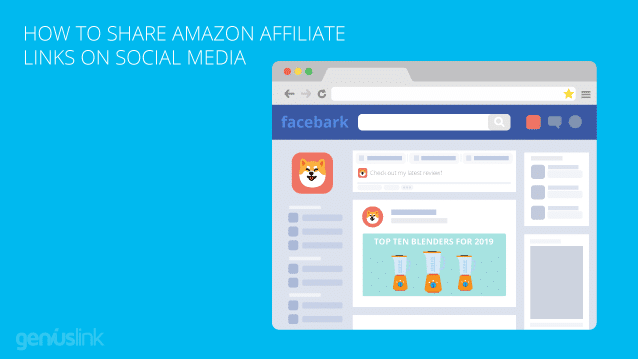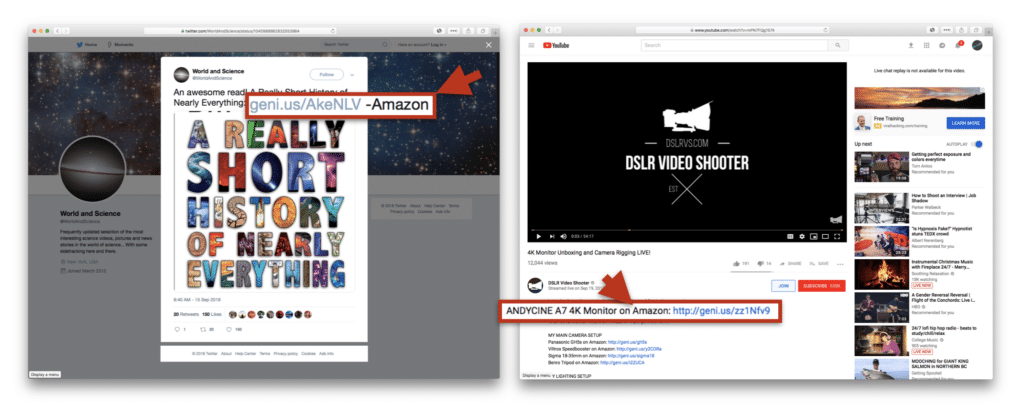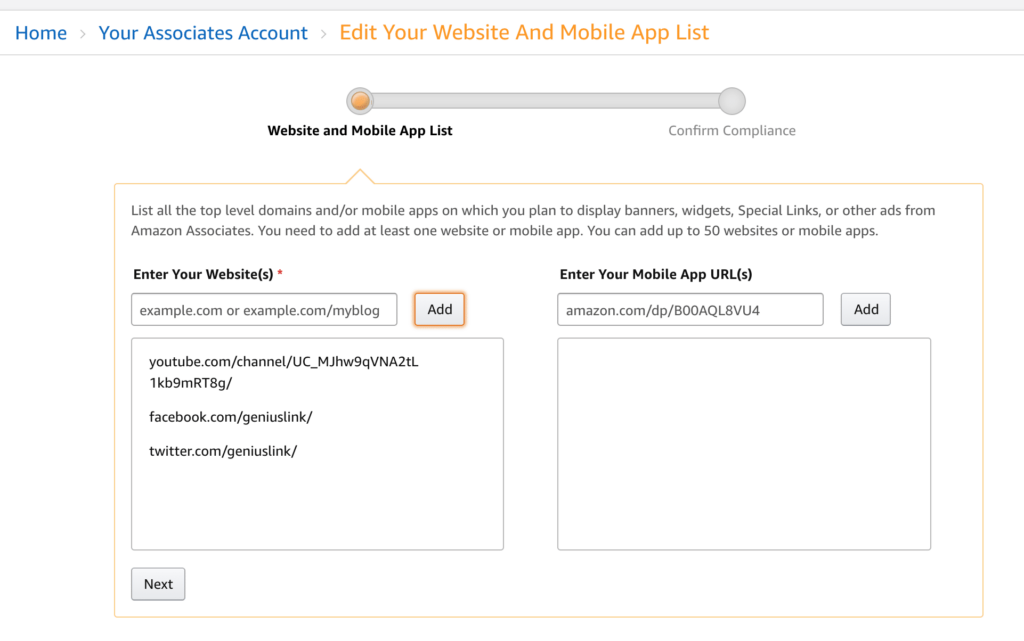Guide to Sharing Amazon Affiliate Links on Social Media
-
Jesse is a Native Montanan and the co-founder and CEO of Geniuslink - or, as he likes to say, head cheerleader. Before Jesse co-founded Geniuslink, he was a whitewater rafting guide, worked at a sushi restaurant, a skate/snowboard shop, was a professional student, and then became the first Global Manager at Apple for the iTunes Affiliate Program.
- September 12, 2023

Affiliate links on Facebook, YouTube, Twitch, Pinterest, Twitter, and Instagram our crucial to affiliate marketing, especially for Creators (authors, musicians, filmmakers, photographers & videographers, streamers, and the many others who make wonderful things to share on the Internet) to interact with their peers and audiences.
These platforms are also incredibly important to share recommendations for the books, music, and films these artists work hard to create as well as the tools necessary during the creation process.
We figured it was about time that we wrote about how to use Amazon Affiliate links.
When done correctly, recommendations on social media can be incredibly lucrative revenue channels for Creators by taking advantage of affiliate marketing and the Amazon affiliate program.
While some misinformation is still floating around the Internet, using Amazon’s Associates Program on social media platforms is completely allowed.
However, there are a few things to be cognizant of, just like using the Amazon affiliate program with a blog, to ensure good standing and a healthy relationship.
We’ll dive into the three main tenets to remember when posting affiliate links on Facebook, and other media.
As well as a few bad ideas and attempt to clear up some ambiguity in regards to using Amazon links on YouTube, Facebook and their social media peers.
Please note that while we’ve organized and summarized some of the most common questions in regards to posting affiliate links on Facebook, YouTube, Twitch, Pinterest, Twitter, and Instagram, there is no substitute for being familiar with Amazon’s Affiliate Operating agreement and Program Policies that dictate the use of their affiliate program.
If you haven’t yet, we’d strongly encourage you to review those. Additionally, Amazon’s Resource Center recently published an incredibly helpful guide to sharing links on Social Media that we’ll quote from periodically below.
Is It Okay?
Can I put Amazon Affiliate links on Youtube? Do Amazon Affiliate links work on Pinterest? Can I use Amazon affiliate links on Facebook?
Yes! We hear these questions all of the time and one of the great things about the Amazon affiliate program is its versatility. While “offline” use (email/ebooks/PDFs) isn’t allowed, Amazon is quite okay with you sharing your affiliate links with your audience on social media channels, though with a few caveats. Further due to the nature of an Amazon affiliate link, they can be used across the many different social media platforms, and through third-party tools, to make product recommendations and earn commissions.
Amazon explicitly states, “You can share on social networks where your readers are” and goes on to elaborate by saying “…what you’re allowed to use on your website is what you’re allowed to use on your social media feeds.” via their recent guide to sharing links on social media.
However, it’s important to note the three tenets of posting Amazon affiliate links on social media:
1/ Link Cloaking
As many readers to our blog know there are many limitations to the Amazon affiliate OneLink service such as not working for links on social media. This then requires a third-party tool, such as Geniuslink, in order to fully serve and monetize the links a Creator shares with their audience.
When asked about this, Amazon states their acceptance with the following language:
Can I use third-party tools to create and share posts?
Yes, as long as the resulting post is compliant with the OA and Program Policies. (source)
And in their Program Policies addendum to the Operating Agreement referred to above they state:
(w) You will not use a link shortening service, button, hyperlink or other ad placement in a manner that makes it unclear that you are linking to an Amazon Site. (source)
This simply boils down to ensuring transparency and building trust when you share a link and this is actually a lot easier than it sounds.
Amazon says, “They will trust you more if you are transparent about where you are directing them.” (source) and we wholeheartedly agree.
This is done by simply including a mention of “Amazon” in close proximity of any link you share on social media to let your audience know where a link is directing them. This can be the word “Amazon” after the link or including Amazon in the call to action before the link.
For example:

Another option to ensure compliance, not only with link cloaking but also with including an affiliate disclaimer (discussed next), is to use a “Choice Page” – an optimized landing page that is built to ensure Amazon compliance and encourage interested consumers to buy.
You can cleanly organize your affiliate links on Facebook, YouTube, Twitch, Pinterest, Twitter, and Instagram through Choice Pages. Find more information about Choice Pages and the various ways they can be used.
2/ Affiliate Disclosures
Transparency is important! Not only for your audience (to inspire trust which leads to higher sales and conversions), but also for Amazon (see the previous section) AND the Federal Trade Commission (FTC)!
Ultimately, this means two disclosures, one at the link level for the FTC and a second one at the channel level for Amazon.
FTC Affiliate Disclosure
With each post/tweet/video you publish that includes an affiliate link you have two requirements.
First, as noted in the section above, it is important to note “Amazon” in proximity to your Amazon affiliate links to ensure your readers know where they are being directed.
Second, the FTC requires “that material connections between advertisers and endorsers are disclosed to customers.”
As a result, you will also need to include a short disclaimer that shows the financial relationship. Unfortunately “#affiliate” isn’t enough in these cases according to the FTC. Amazon instead recommends using “#ad”, “(paid link)”, or “#CommissionsEarned.”
Amazon Associates Disclosure
Further, when you are using the Amazon Associates Program, you need to include Amazon’s affiliate disclosure.
In order to do this Amazon strongly recommends you use this sentence — “As an Amazon Associate I earn from qualifying purchases.” –to keep Amazon in good standing with the FTC.
Amazon has clarified where this disclosure should live and states:
For social media user-generated content, it must be associated with your account. This can be on an “about” or “info” section. For individual social media postings, this full statement is not required.” (source)
John Doe
If this is the least bit confusing, I’d encourage you to read through our in-depth blog about FTC compliance when using the Amazon Associates program.
Again, if you’d rather avoid including all this info in your social media posts and profile we’d encourage you to use our fully compliant Choice Page tool that includes both an FTC disclosure built into the page and a direct link to the Amazon Associates disclosure.
3/ Listing Channels
The third tenet of using Amazon affiliate links among your social media channels is to ensure you list where you plan on using your links. This is done in the Amazon Associates Central dashboard.
You may not remember this step when you first signed up for the Amazon affiliate program but that’s okay as it’s easy to jump back in and make the addition. Go to Account Settings then “Edit Your Website And Mobile App List” to include all of your social media channels, as well as your websites/blogs.

Further, we’d encourage you to follow this advice to help eliminate the email from Amazon’s affiliate compliance team asking about “your referring traffic” that is sure to add some stress and grey hair:
- Add all channels before you start referring traffic. Further, it’s important to add the full channel (eg. “twitter.com/geniuslink/”) not just the domain (eg. “twitter.com/”)
- Be sure to include “geni.us” if you’re are using Choice Pages.
- While very repetitive, we also encourage you to update the website list on EACH of the Amazon Associates Central dashboards you are active in (eg. affiliate-program.amazon.co.uk/ if you are using the Amazon.co.uk affiliate program and associates.amazon.ca/ for the Amazon Canada affiliate program).
Not Allowed
Outside of the three tenets mentioned above, there are four more statutes that you should be cognizant of when using the Amazon affiliate program and to posting links on social media:
1/ Only In Your Channel
No one likes spam and spamming affiliate links isn’t good for anyone. As a result, Amazon’s affiliate program makes the requirement that you only post links when “You are the sole moderator of the account that you plan to post to” (source). This means that posting your affiliate links in forums, groups or in replies/comments isn’t cool.
2/ Public
Amazon employs an intense review process to ensure compliance within its affiliate program and in order for that process to work it’s important that your links are posted somewhere public and widely accessible. If Amazon’s compliance team can’t access your link to review them then you’ll likely be getting one of those dreaded emails asking about “your referring traffic”.
3/ No paid ads
While the Amazon affiliate program can provide a great way to get insight into the effectiveness of your marketing campaigns by using different tracking IDs per campaign, placement and/or call to action, this process is not permitted with paid ads on social media. Amazon states:
No, you cannot use affiliate links in paid ads or pay (“boost”) posts that include affiliate links. They cannot contain or be used to advertise your Amazon affiliate links and send the customer directly to Amazon. (source)
However, there is a solution to this – Choice Pages. Amazon elaborates on the above statement saying that it is okay to “use paid ads to send users directly to your participating Site…” where a “Site” can be a Choice page (but don’t forget to list “geni.us” on the Sitelist inside the Associates Central dashboard, #3 above).
4/ Don’t ask for clicks or bookmarks
While it may seem like a good idea to mention that your channel is made possible by buying products on Amazon after clicking your affiliate links during the middle of your stream you are actually jeopardizing all of your hard work. Amazon specifically forbids this behavior in their Operating Agreement.
Amazon states “You will not offer any person or entity any… incentive…” in section 6 (g) of their policies. We’ve seen this specifically interpreted as not being allowed to ask people to click your affiliate links or buy random products after clicking your links as supporting you and your channel is considered an incentive. We encourage you to stick to recommending a specific product and if necessary mentioning that a link to purchase that product can be found in your show notes, video description, or comments.
Taking that one step further Amazon also states “You must not encourage customers to bookmark your Special Links.” in section 2 (b) of their Policies page. There isn’t much room for confusion on that one.
Please don’t do it!
Conclusion
Social media is has become an incredibly powerful medium and the various social media platforms have become amazing places to build and curate an active and engaged audience.
This, in combination with affiliate marketing, creates unique opportunities to open up significant revenue streams that weren’t there a decade ago. But with great opportunity comes responsibility (just ask Mark Zuckerberg) so please be mindful when sharing your affiliate links on Facebook and across your various channels.
Good luck and please let us know if you have any questions. We look forward to helping you become even more successful.
Author
-
Jesse is a Native Montanan and the co-founder and CEO of Geniuslink - or, as he likes to say, head cheerleader. Before Jesse co-founded Geniuslink, he was a whitewater rafting guide, worked at a sushi restaurant, a skate/snowboard shop, was a professional student, and then became the first Global Manager at Apple for the iTunes Affiliate Program.
Author
-
Jesse is a Native Montanan and the co-founder and CEO of Geniuslink - or, as he likes to say, head cheerleader. Before Jesse co-founded Geniuslink, he was a whitewater rafting guide, worked at a sushi restaurant, a skate/snowboard shop, was a professional student, and then became the first Global Manager at Apple for the iTunes Affiliate Program.
More revenue from every link you share
Geniuslink makes localizing, tracking, and managing smart links dead simple, so you can earn more without added work.
